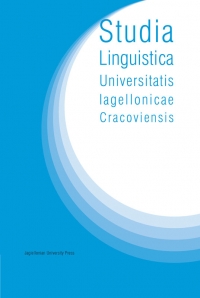Focus dissipation as a narrative and mimetic technique: A case study of Virginia Woolf’s “Blue & Green”
Focus dissipation as a narrative and mimetic technique: A case study of Virginia Woolf’s “Blue & Green”
Author(s): Olga VorobyovaSubject(s): Applied Linguistics, Syntax, Semantics, Theory of Literature, British Literature
Published by: Wydawnictwo Uniwersytetu Jagiellońskiego
Keywords: ludic phenomena; focus dissipation; refocusing/defocusing; narrative and mimetic technique; narrative/mimetic construal;
Summary/Abstract: This paper addresses the issue of focus dissipation as a narrative and mimetic technique based on ludic transformations of Figure/Ground correlation in literary text. Such transformations are triggered by text-driven attentional shifts that violate, shatter, or split the integrity of focal elements in literary texture, thus generating a range of verbal and/ or multimodal stylistic effects. Woolf’s “Blue & Green” (1921) suggests a sample of condensed mimetic and diegetic manifestations of focusing/refocusing/defocusing, which heightens textual ambiguity caused by temporal, spatial, epistemic, colour, and substance oscillations. The split of initially focal elements into a set of microfoci, accompanied by the interaction of sensory (visual, auditory, tactile, olfactory, and kinesthetic) modes, gives rise to what is known as verbal holography in literary mimesis. The motion of foci, highlighted by the wave-like chains of short nominative sentences and excessive syntactic parallelism, creates a narrative construal of dynamism vs. stability as an iconic trigger of the readers’ emotional response.
Journal: Studia Linguistica Universitatis Iagellonicae Cracoviensis
- Issue Year: 138/2021
- Issue No: 3
- Page Range: 145-157
- Page Count: 13
- Language: English

